
 NCKU Arch 112
NCKU Arch 112
方 俊 凱
古 爵 誌
蘇洛 山之形 林永濬苑景
莊昱潔若即若離 / 越線記
方玟心後山新知 二 三 四
呂珂 曹詠行 吳宇承 吳昀軒 跋舍 364:1的正反日常 浮田
你我之間 五 六 七 八 陳若欣失序之島 九
吳 光 庭 林文馨 黃筱筑
蕭子琳
公共新秩序 再現水色
漫行薈萃城 十 十一 十二 林 靜 娟
游邛希 徐家昱 陳佳衛
洪懷昀
重返靈山 家也非家
敬畏與否
花現花嶼 十六 十七 十八 十九 鄭馭 都市游牧二十
陳 玉
霖
虎尾美術館
林蜜絲 余承蔚 潘中昱 張易夫 蒂蒂巴潘的集合點
傳產的現代記憶 西城故事
二十一 二十二 二十三 二十四
廖子瑄居之所向 二十五 張 鶴 齡 陳曉柔 廖振嘉 李曄舜
街角舞影城市舞台 集地相守 回家的路 二十六 二十七 二十八
南橫公路自然導航 十三 十四 十五 林 宛 蓁
黃靖琁 謝侑呈 林孟萱 未竟之路 風化港都
黃 聖 鈞 吳孟軒 李欣恬 家,棲居詩學 擴增殘垣 二十九 三十
薛 丞 倫 鍾沂璇 黃旗蕾 佔領宣言 消長之間 三十一 三十二 賴 伯 威 陳奕中 陳映融 田城園市 遺流之界 三十三 三十四 柳 川 肯 江子沛 張偉平 高鏡融 樂園 多重現實 混聲之城 三十五 三十六 三十七

大崗山做為北高雄平原的制高點,是一座石灰岩山體。自古以來,人類對於大崗山之態度為各取所需的:宗教 看中其清幽的自然性質創造超自然場域;軍事利用突出 性達到監視平原甚至西部沿海之效果;水泥產業奪取其 礦材進行加工因應都市發展需要。由於上述三種開發皆 具排他性,導致現狀呈現落後、盤據各方的狀態。分身,是發生於大崗山上的現象,宗教、軍事和水泥產 業因為時空背景、使用和需求而在山體上和山腳下有不 同程度相關的開發,能夠述說山體邊界兩側的黏著關係。我嘗試使用分身的邏輯,植入纜車、平面道路、豎橋和 暗示的空間重新塑造在山體上的移動經驗,探討人和自 然之間的關係。
As the commanding height of the Kaohsiung Plain, Mt. Dagan is a limestone mountain.Human have adopted Mt.Dagan according to their needs: religion create a supernatural field; the military monitor the plains; the cement industry seizes its mineral materials.
Horcrux is a phenomenon that occurs on Mt.Dagan. Religion, military and cement industries have different degrees of related development which can describe the adhesive relationship of the mountain boundary.
I try to use the logic of horcrux to reshape the experience of moving on the mountain and explore the relationship between human and nature.
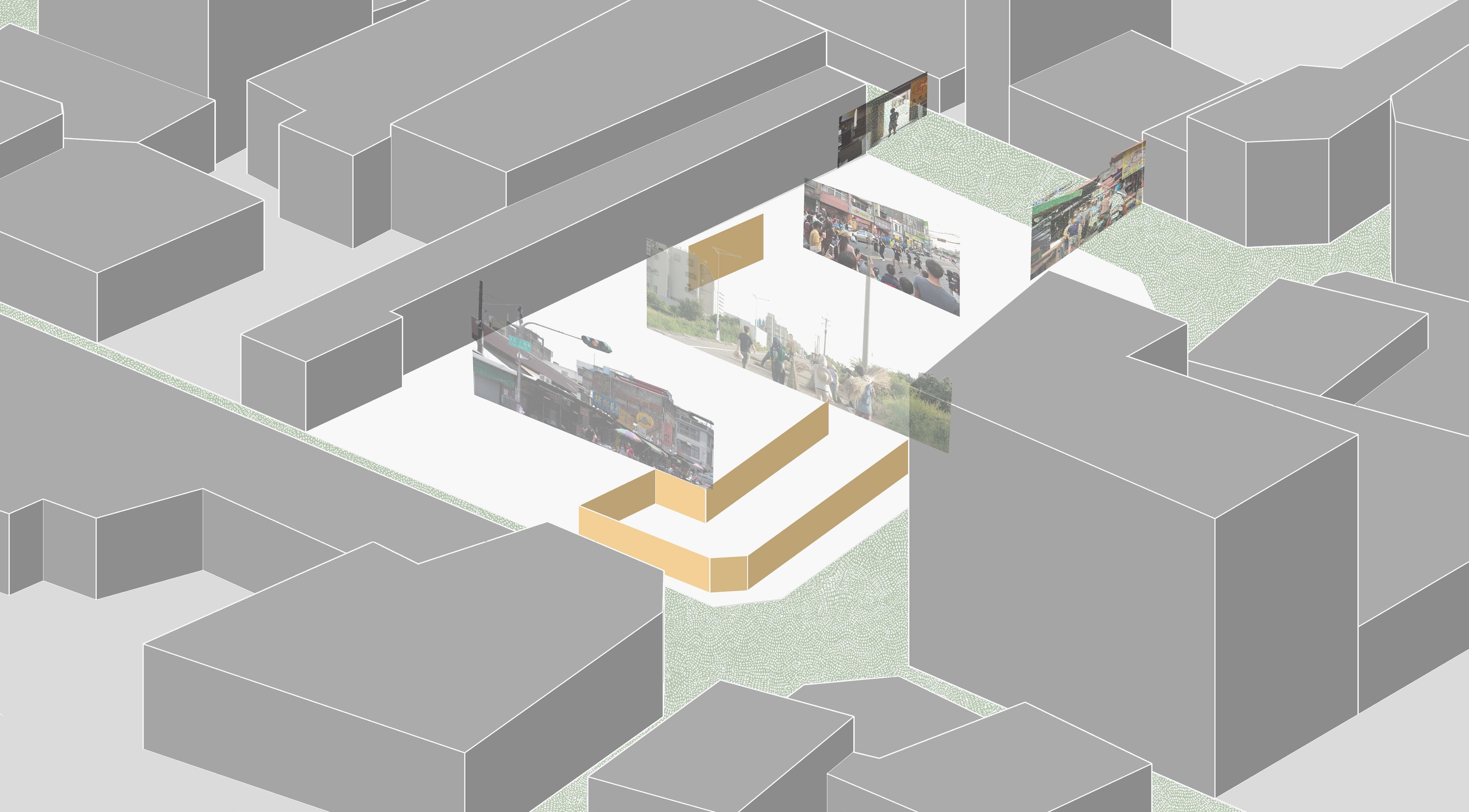
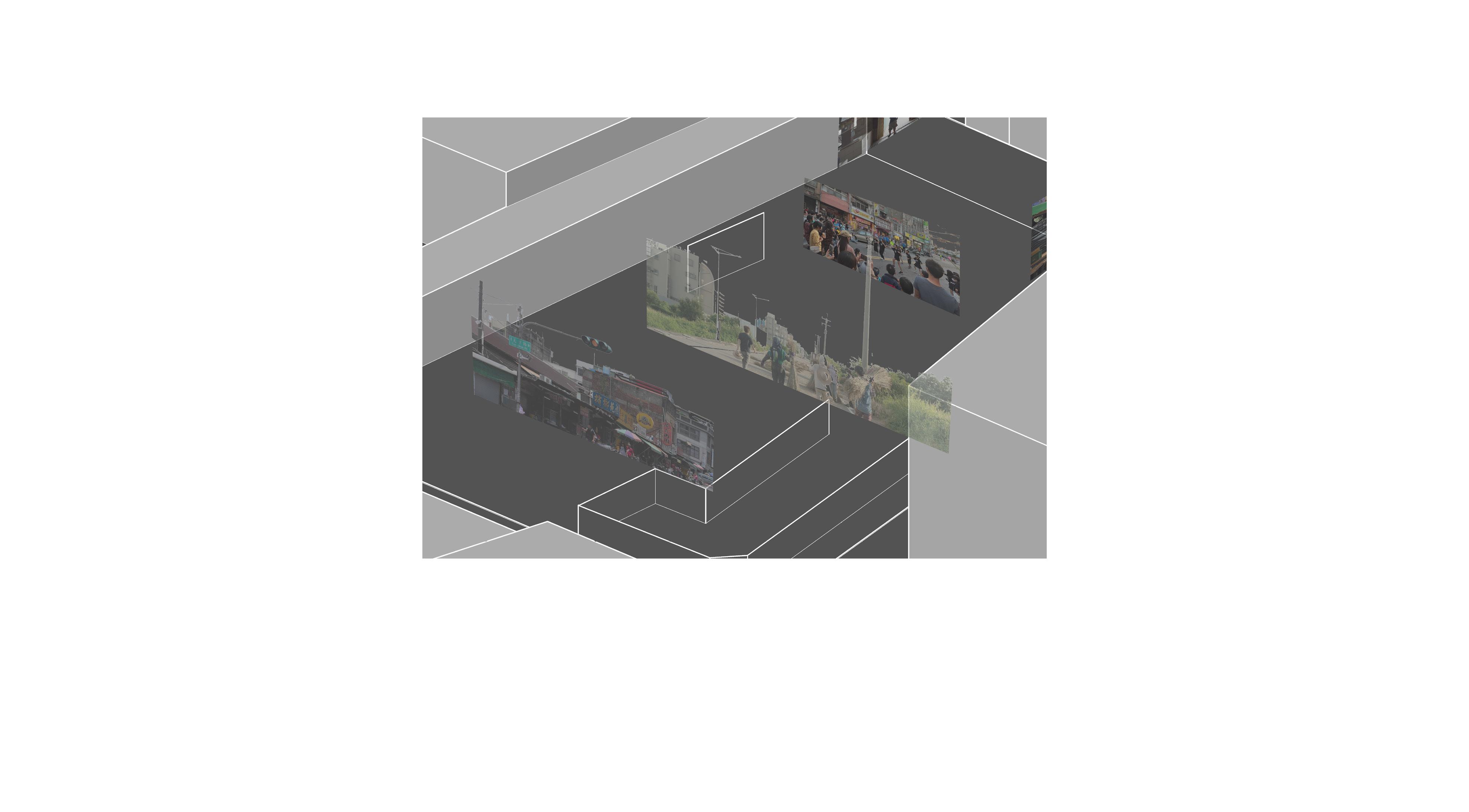
明治年間已經存在的苑裡市場,在苑裡鎮民的日常生活 中,已成為不可或缺的場所。每逢初一、十五或者重要 的節氣,苑裡市場的熙攘人潮更凸顯了深植於常民生活 中的文化傳統。 苑裡市場豐富且多樣的零售環境,不僅滿足當地居民的 內銷需求,更成為海線生鮮食品的重要產銷中心。鄰近 大甲、新埔、白沙屯等地的居民,也紛紛選擇苑裡市場 作為購物或消費的首選地點,從而突顯了苑裡市場獨特 的人群聚集性。
然而,隨著一場大火,焚燒掉了人們賴以維生的場所, 也摧毀了原本欣欣向榮的社交氛圍。而事件的發生的四 年過去,市場因為種種原因擱置了重建工程。不禁使我 們開始思考這塊空間新的利用價值與更多的共享可能。
The rich and diverse retail environment of Yuanli Market not only meets the domestic sales needs of local residents, but also becomes an important production and sales center for overseas fresh food.
However, a fire burned down the place where people relied for a living and destroyed the originally thriving social atmosphere. Four years after the incident, the market put the reconstruction project on hold for various reasons. It makes us start to think about the new utilization value and more sharing possibilities of this space.
市場遺址的公共性與記憶符號
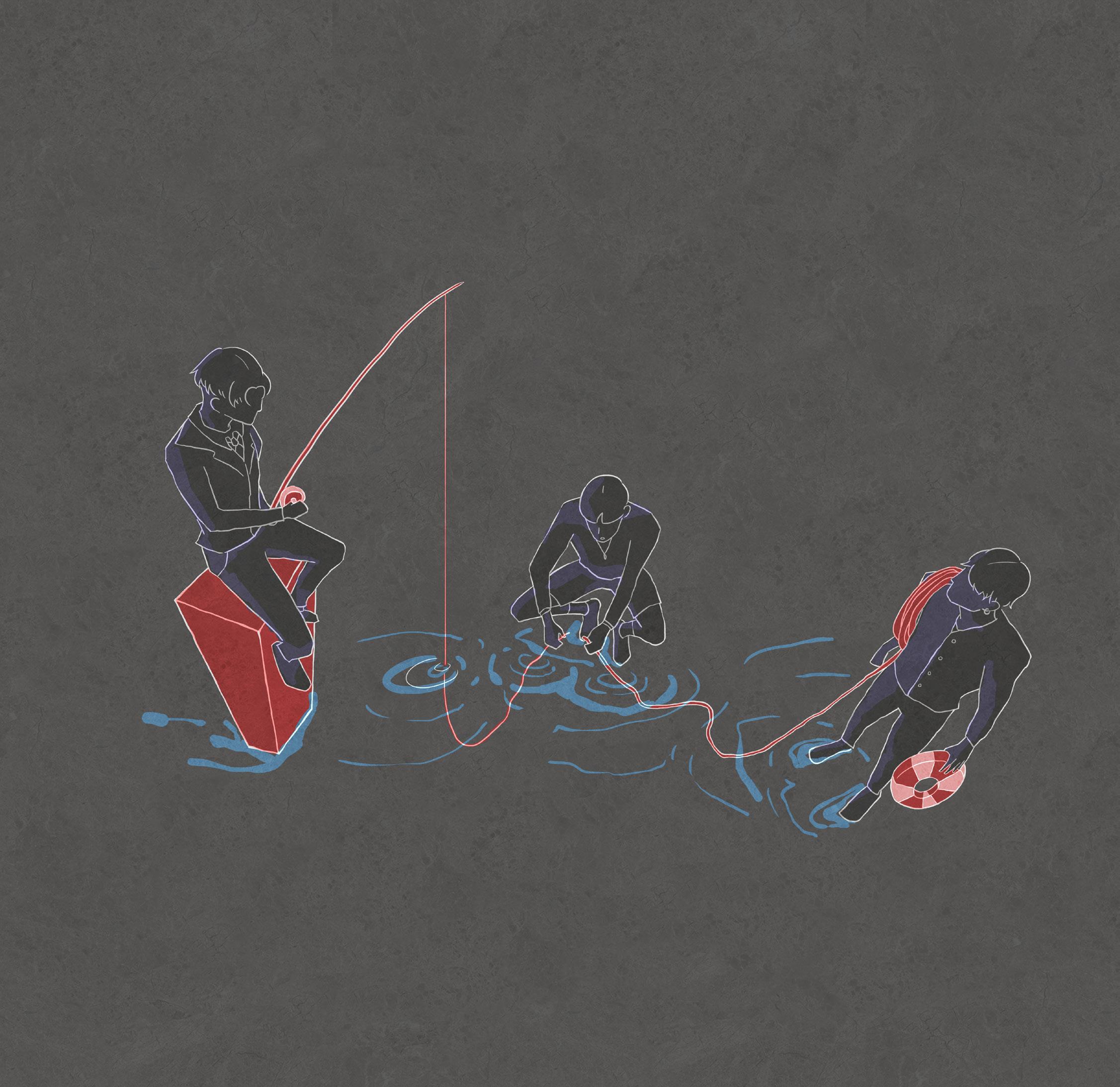
從基礎設施的歷史疊圖可以發現,金廈在政治、經濟上 的牽制,以空間的形式呈現在地圖上一目了然。人們在 飲用大陸水的同時,一邊接收到中共衛星發射的國家級警報,如此荒唐的現象真實發生在金門。 我想藉由連接一座金廈大橋,以
金門在無法完全成為任何一方的情況下,如何活出自己?
In the 1950s, USA proposed to Taiwan to delineate Taiwan strait medium line. Taiwan is on one side and Kinmen is on the other side, "in between" two countries.
年代美國向中華民國政府建議劃定台灣海峽中線,
這項基礎設施作 施力點,去揭露兩岸間真實的荒謬。
台灣在一方,金門被劃在另一方。與台相隔兩百里,與廈僅有兩公里,金門成為兩者「之間」。
唯有越線,才會發現。
From the historical map of infrastructure, it can be found that Kinmen and Xiamen have strong political and economic ties. While people were drinking water provided by China, they also receiving national-level warnings from satellites launched by them. Such a ridiculous phenomenon really happened in Kinmen.
I want to expose the absurdity by connecting a Kinmen-Xiamen Bridge. If Kinmen cannot be on either side, how can Kinmen become itself?
bridge
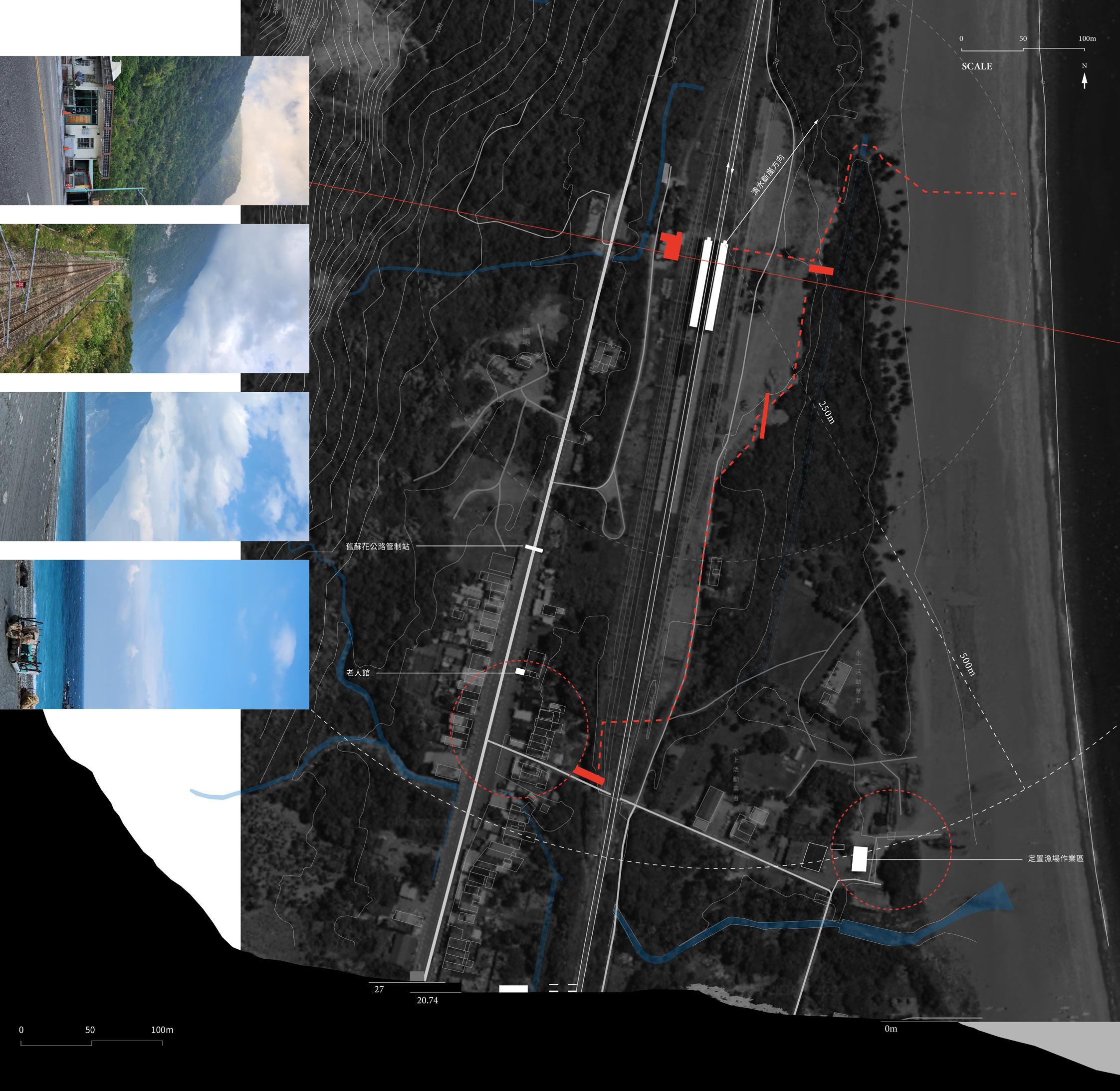
過去花蓮被稱為「後山」,依山傍海、遠離城市。如今 在觀光經濟發展的步調下充斥著膚淺的符號,缺乏地方 脈絡的發展讓我逐漸失去對花蓮生活的認同。我認為花 蓮獨特之處是居於山脈與海洋之間的空間感受,形塑了 道路、氛圍、步調等我們感知、記憶地方的邏輯。在縱谷平原最北的崇德,是平行的山脈與海岸地景的起 終點。台九線切穿部落,維繫著居民的生計,卻也是空 間中的巨大裂痕;如今三小時便能往來台北花蓮,一趟 抽離都市的旅行除了遠行,步調更決定了體驗的好壞。 藉由將聚落北端的崇德車站站體拆解、延長、南移,我希望脫離高速的移動系統、回歸人類的空間和時間尺 度,感知山海的路徑,也讓地景重新成為居民對「家鄉」 的印象。 重新認知花蓮。 在緊依山海的距離、移動與停留之間 重新認知花蓮/家
Hualien was known as the "Backland". Amidst the pace of tourist-driven economic development, there is an overflow of superficial symbols.
Hualien's uniqueness is defined by the space between mountains and the ocean, shaping how we perceive and remember the essence of the place through its roads, ambiance, and pace.
By disassembling, extending, and relocating the Chongde Station, I aim to break free from the fast-paced transportation system, returning to a human-scale perception of space and time. This transformation seeks to reconnect residents and visitors with mountain and sea, making the natural landscape into a renewed impression of "home."
後山新知
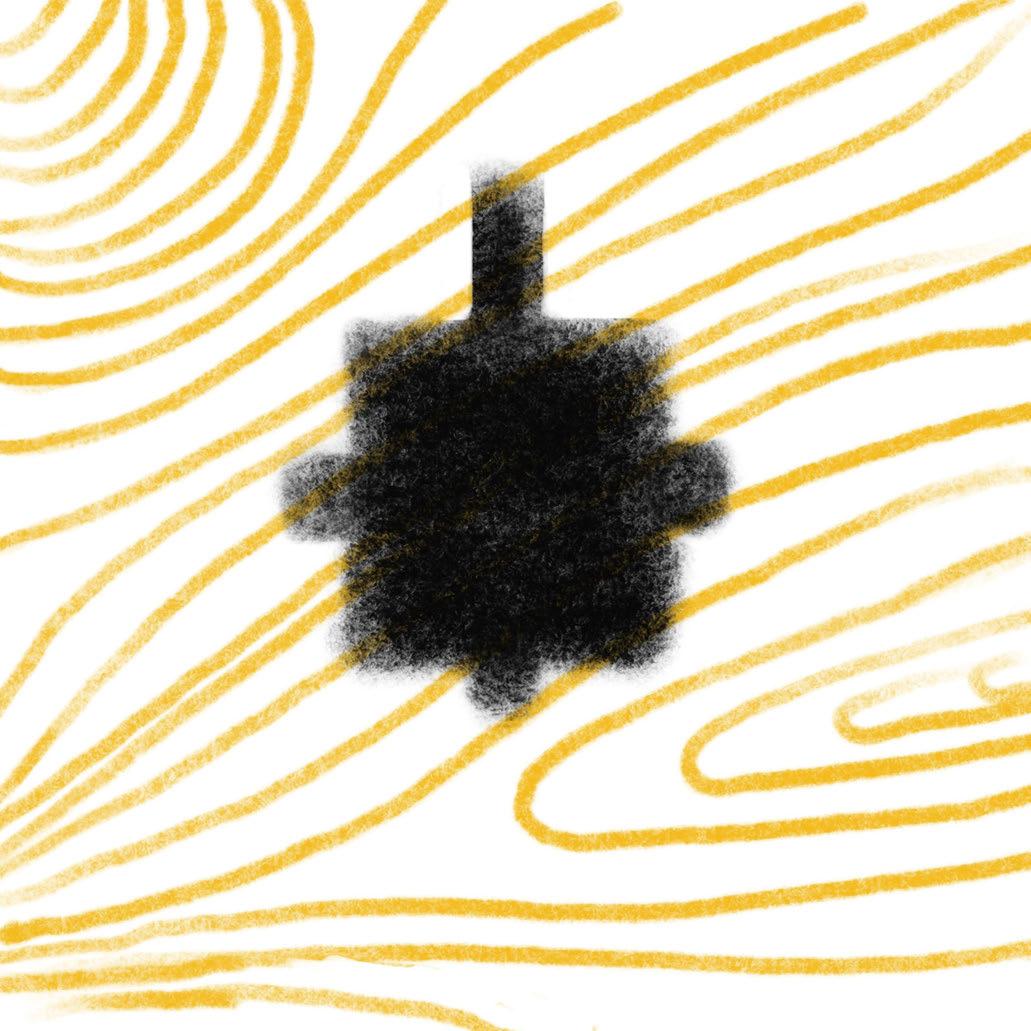


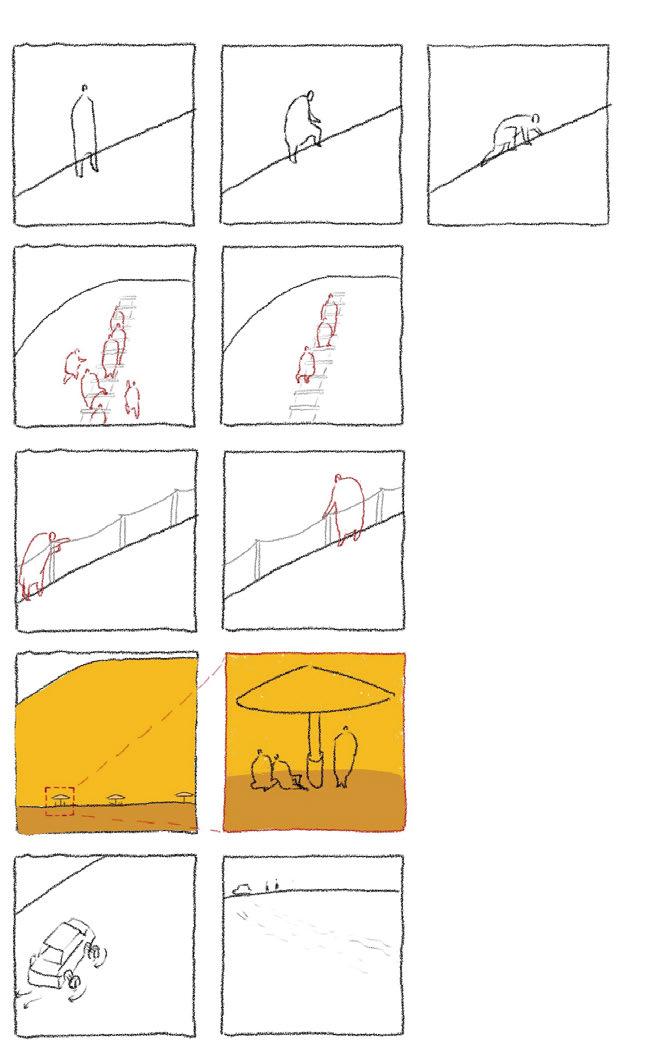


設計位於敦煌鳴沙山沙漠的中心,與世隔絕,只能先經 歷十公里的沙漠徒步。迷途之人經過長途跋涉來到這裏,短暫休憩之後,便再度出發。
跋,指陸行,涉,指水行,出自《左傳·襄公二十八年》
常用于形容旅途的艱辛。但 與原始釋義不同,我特指在沙漠中的跋涉。與常規爬山不同,沙漠徒步更為艱險。沙礫鬆軟,每一 步都會下陷,常需手腳並用地前進。而極端炎熱乾燥的 氣候,偶發的沙塵暴,低至零下的寒冷的冬季,都給人 們的生存提出挑戰。
建築在此將回歸最原始的狀態:「一個足以遮蔽風雨的 栖身之所」,同時,將附帶滿足十個人在此生存一天所 必備的機能。坐落在荒無人煙的沙漠中心,能短居一日的小屋是什麼樣子?
The design is located in the center of the Mingsha Mountain Desert in Dunhuang. It is isolated from the world and can only go through a ten-kilometer desert hike first. The lost people came here after a long journey, rested briefly, and then set off again.
Unlike conventional mountain climbing, desert hiking is more difficult and dangerous. The gravel is soft and sinks with every step, so you often need to use your hands and feet to move forward. The extremely hot and dry climate, occasional sandstorms, and winters as cold as subzero all pose challenges to people's survival.
The building here will return to its most primitive state: "a shelter sufficient to shelter from the wind and rain." At the same time, it will have the necessary functions for ten people to survive here for a day.
跋涉山川,蒙犯霜露。
舊河堤
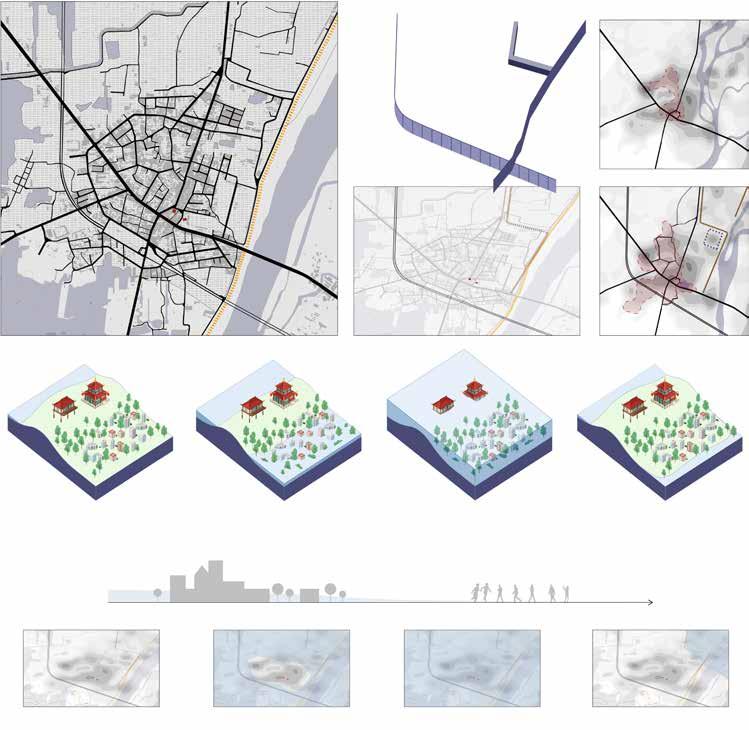
親水尺度 限制、災難
在林邊鄉最主要的兩座大廟為三山國王廟與媽祖廟。特 別的是,廟的坐向皆是面向聚落,通常航海守護神應該 是面向海,但因林邊經常遭遇水災,這個信仰是出於對 水的恐懼、希望能保護聚落免遭水淹,因此以背向海的 姿態存在。 廟的出現帶動周邊發展,形成市街,是一個信仰空間高 度與日常生活混合的狀態。直到現今,聚落範圍由高架 後的鐵路、新建的堤防及拆掉舊堤防後地勢微高的邊界 大致定型。隨著技術發展及進步,林邊溪上游到下游的 治水措施及設備也愈來愈完善,淹水的邊界已漸漸遠離 聚落,且水已經從一種限制活動及凌駕於人之上的狀態 轉變成可以親近人體的淺水尺度,因淹水而存在的信仰 與地的黏著性也漸漸消失,並隨著環境的變動及水的邊界跟著位移,對現在生活在林邊的人來說,
信仰位移|信仰隨環境變遷改變而產生 新的公共性的可能
In Linbian, two main temples exist to protect the community from flooding. The emergence of the temples has driven the development of the surrounding area, forming a market street. It represents a state where spaces of faith are highly intertwined with daily life.
With technological advancements and progress, the boundaries of flooding have gradually moved away from the settlement.
In the present day, I wish to explore how to discover new communal experiences and faith amidst the antiroutine of flooding and the daily habits of life.
1/365 Negative Routines



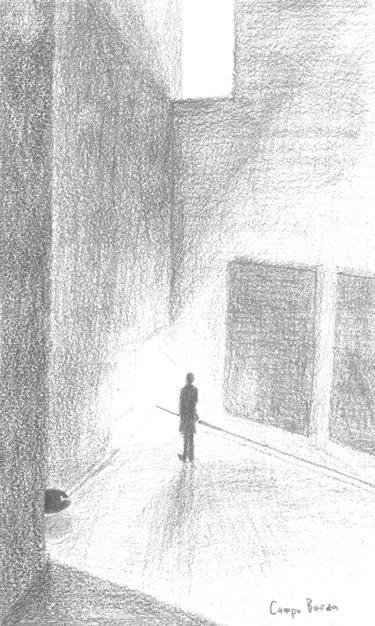





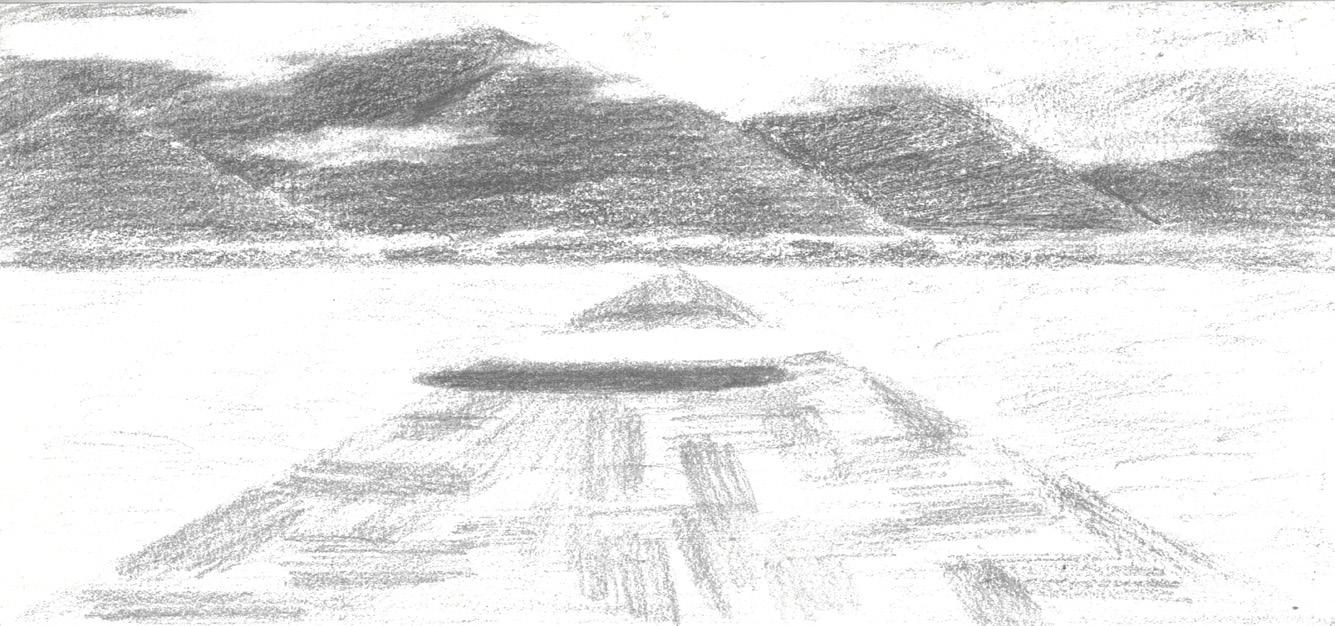
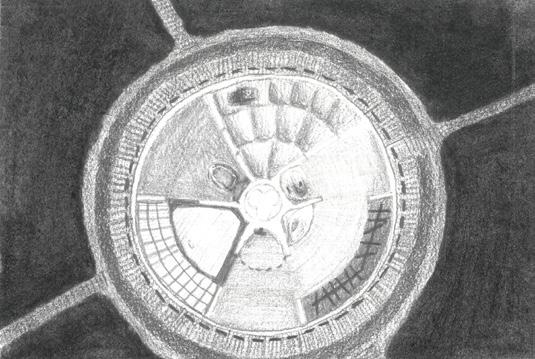
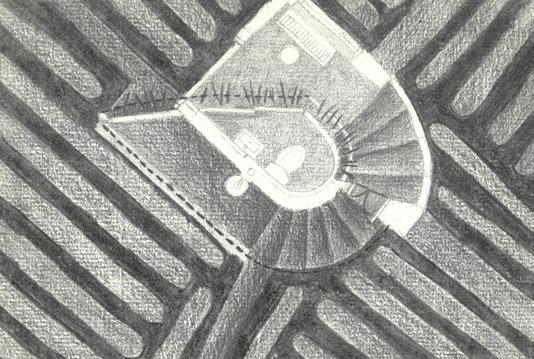

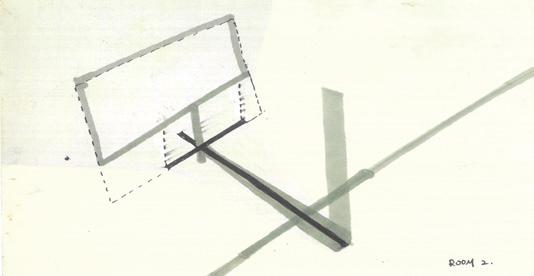
台灣的聚落型式反映人與田地的關係。濁水溪以北的散 村聚落使生活與農田的物理距離縮短,以南的集村聚落 則反。農業首都雲林的城、鄉、村結構呈顯明顯的集村型態,人口外流、少子化、總人口下降為現況。
我認為對於雲林鄉村來說,聚落的樣態與人口的變遷使田成了窗外景,可望不可及。 此階段研究人、厝與農田於時間、活動的各種因循與衝突下,靜態的建築如何對應環境的變動。階段性設計將實用性與娛樂性帶至田間,滿足農忙期間 工作者的需求,成為休耕期間田間活動的中心。形式上 從「家的拆解與重組」出發,以短時卻必須的空間為主, 根據基地特質重新定義並加以組合,形成每個季節都能 發揮特定機能的場所。新型態、循環、未來性為關鍵。 下階段將擴大討論人、厝、聚落與田的關係。
Two types of settlement in Taiwan reflect the distance between human and crop fields, especially in Yunlin, the capital of agriculture, where population decreases.
The project focuses on bringing people towards the cultivating area, using architecture as connection.
The research starts by discussing the new forms of architecture regarding the relationships between dailylives of people in and outside the fields and seasonal farming of peanuts and garlic.
The approach includes reinterpreting the spaces that constitue a home, deconstructing and transforming them into new means which will be taken to the next phase.
建築如何使人走進田間?
Fields of Fortune

透過建築轉譯的方式來敘説一個故事,一個關於想自殺者、管理者與親屬之間的關係。
借由三者之間的棲所空間,展現了社會的現況。我認爲 自殺在社會上屬於非秩序的行爲,而管理如同社會上制 定規則的人們,兩者相互產生對抗,但又依靠著彼此。 親屬相較之下停留時間較短屬於第三者的存在,但又是影響決定者至關重要的因素。 當這些關係建立後我以建築的形式、構造、材料、基地等設計選擇來對應,如此展開了我的議題。
我的畢設從我個人的經驗出發,試圖討論一個有自殺傾 向的人最後抉擇的過程。
This thesis project is based on my personal experience and attempts to discuss a person with suicidal thoughts.
By architectural reinterpretation, a story is told about the relationship between suicidal person, manager, and relatives. Through the discussion of living spaces, it will depict the current situation of society. In my opinion, suicide is an unordered behavior, whereas management is like defining fixed rules in society. In comparison, relatives are considered as a third person but will inevitably affect a person who wants to commit suicide.
Finally, this topic will be presented by my architectural design choices.
建築如何呈現社會現象?
Between me and you
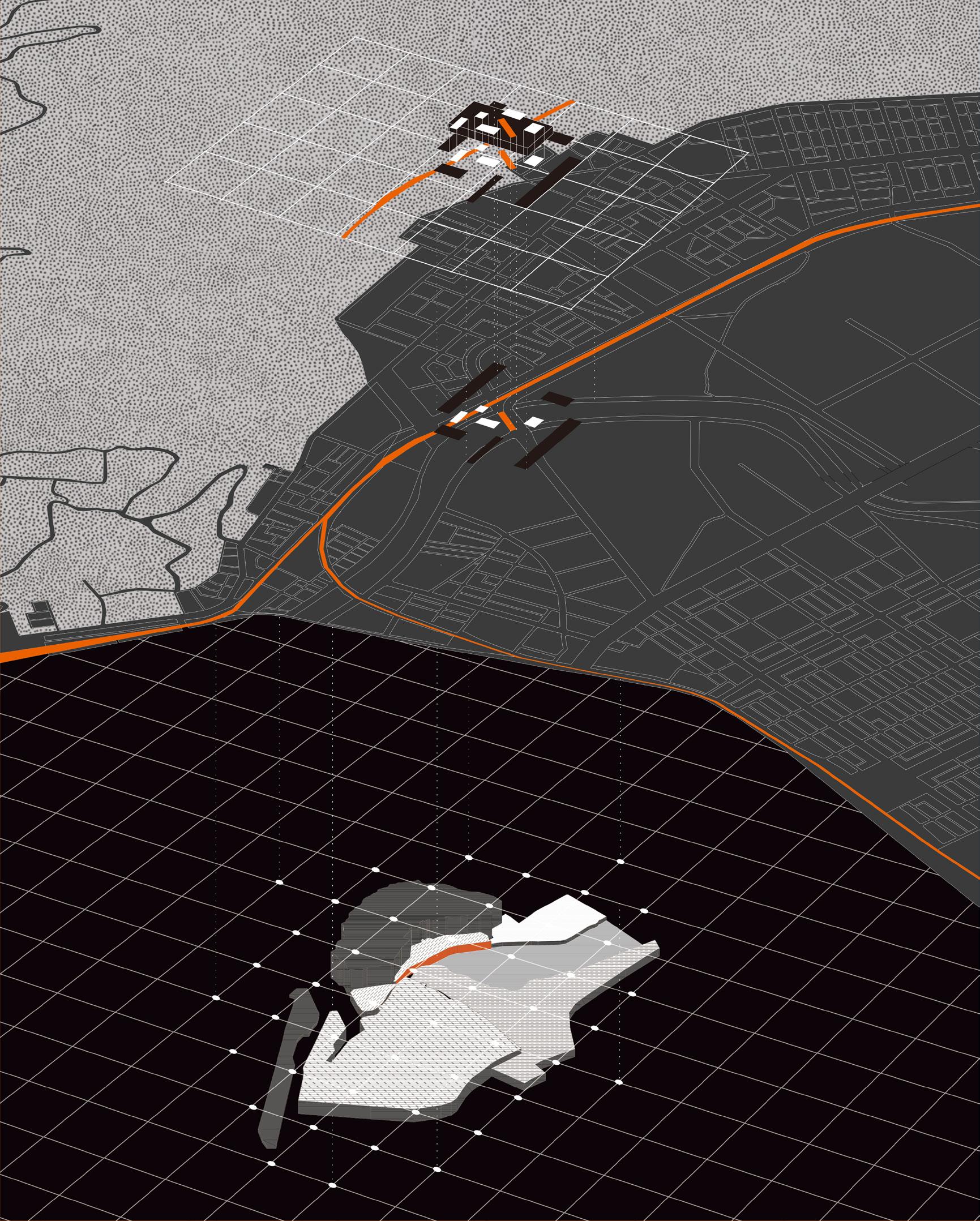
隨著高雄從日治時期的開發這些在現在被認定為界線的 退化元素(鐵路、愛河、路橋)從無到有,然而現在從 某種角度上再從有到無,邊界卻依然存在並且剩下了更 多的「空」。 面對這些被剩下的空,它剝奪了對於城市「之間」的感知, 因此提出重新尋找元素之間空的集合體,找回屬於城市 的空白。 城市空白也可能成為相反的東西:生活的高潮,失序之 島的序章從此開始。鐵路地下化了,屬於城市內的邊界卻從 未消失。
從輕軌開始,對於城市的認知從慢開始,意識到屬於高 雄的空和界線。
"Railway undergrounding has occurred, yet the boundaries within the city have never disappeared."
Starting with the tram, the perception of the city gradually unfolds, becoming aware of the negative space and boundaries that belong to Kaohsiung.
Faced with these negative spaces, it strips away the perception of the "inbetween" in the city.
Hence, there is a proposal to rediscover the collective essence of the spaces in-between elements, reclaiming the urban voids.

立院不僅是象徵台灣民主化的過程,更反映全民對自由 的渴望。我希望在未來公民參與不再是空談,人們被置 於空間體驗的中心,更靠近民主的發展程序,加強監督政府,同時也讓民主意涵融入日常。
The internal space of the legislature represents the realm of representatives, while the external space embodies those being represented. The purpose of the internal space is the creation of legislation, which is then applied to the external space. The relationship between "law" and "space" in a city begins here.
議會的內部是代表者的空間
民主自由/公共性/自明性
個都市裡「法」與「空間」的關係 , 就從這裡開始。都 市作為民主發展的關鍵空間,街道、議會以外的公共領域,其實為民主意識的推動提供了更多的可能。
是外部選出來的 , 但是外部卻受到内部根本的影響。一
The legislature symbolizes Taiwan's democratization and echoes a collective desire for freedom. I aim for genuine citizen participation, placing people at the heart of spatial experiences, closer to democratic processes, strengthening government oversight, and integrating democratic values into daily life.
, 外部則是被代表者的空間。 内部為了立法而存在
, 所立的法 , 則應用到外部。内部
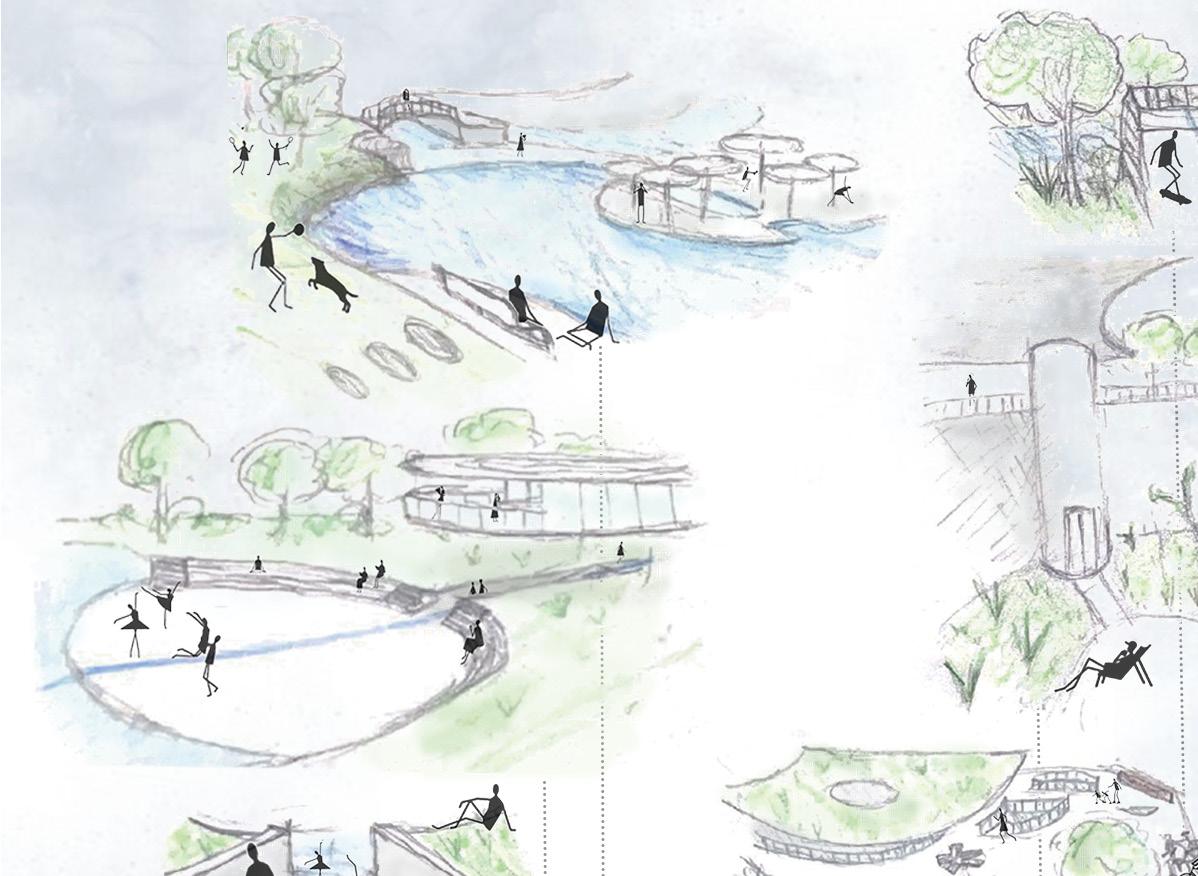
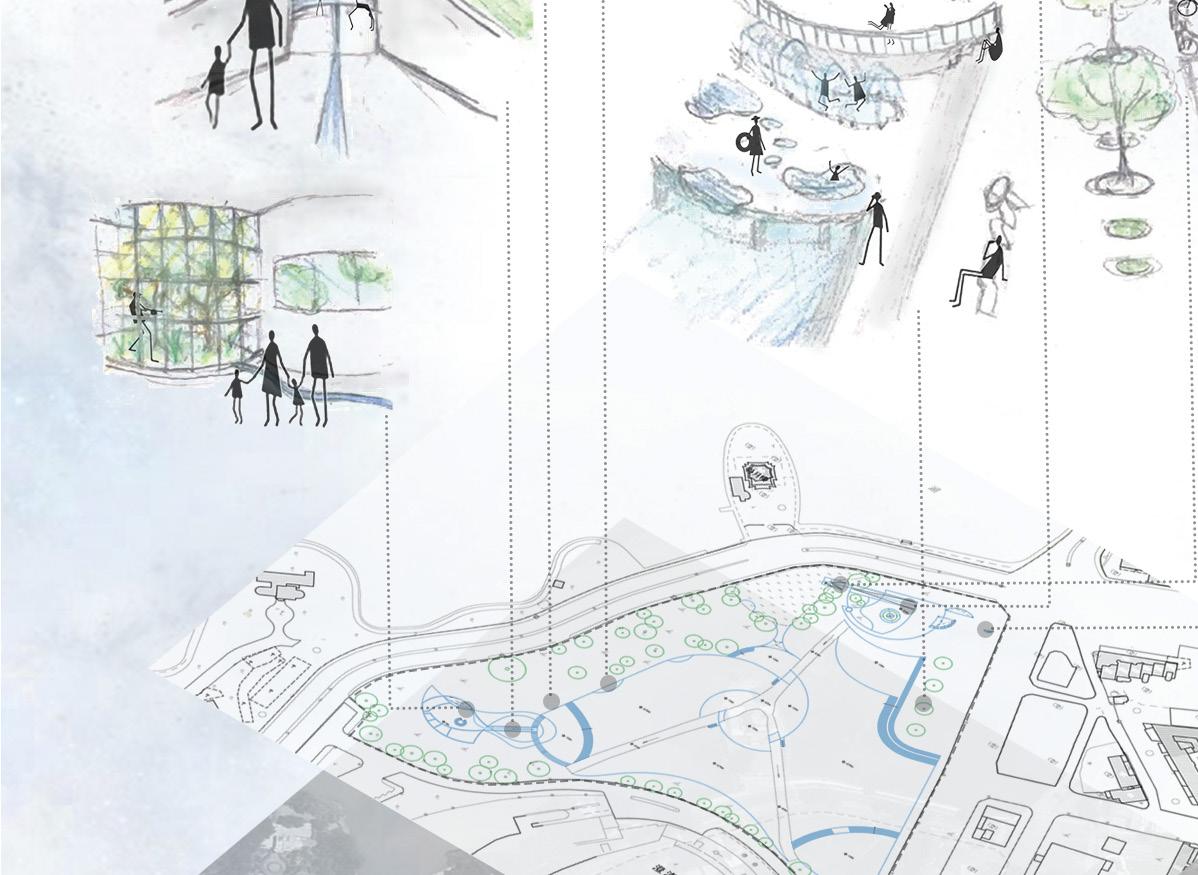



長庚醫院與棒球場的所在,曾是一座調節性埤塘,俗稱﹁小貝湖﹂,如今只剩下幾塊小池塘,造成周遭經常淹水。 在未來,這塊土地將重新開發,更有捷運站駐紮。然而, 政府的提案卻被居民反對,生態、水質及淹水等問題再 次被提出。 因此,拋開原先高樓大廈的提案,我希望能透過設計將 機能空間維持在低樓層與地下層,並透過滯洪池公園及 與捷運站連接的生態歷史故事館,讓來者能重憶起逐漸消失的小貝湖,並重視其生態重要性。地與澄清湖相呼應,卻有著明顯的不同處。
在高雄用水方面佔有一席之地,眾多生態也棲息於此。然而,城市開發也改變著這塊地。
逐漸消失的小貝湖將如何透過設計手 法,重現其原有的功能與生態樣貌呢?
Urban development is also changing the land.
There was once a regulating pond, commonly known as "Xiaobei Lake". Today, only a few small ponds remain, which are often flooded. In the future, MRT stations and high-rise buildings will be built on this land. However, the proposal was opposed by residents, and issues such as ecology, water quality and flooding were raised again.
Therefore, I hope that through the design, functional spaces can be maintained on the low floors and underground, and through the detention pond park and museum, people can recall Xiaobei Lake and pay attention to its ecological importance.
再現水色
澄清湖 (
與小貝湖古稱大埤 ) 自曹公圳新建以來,一直
Recreate the waterscape

位於西門徒步區中央的峨眉立體停車場,將車流引入了 人行路網,並在鬧區中形成低品質的背面空間。面對依 循車輛尺度規劃的混凝土架構,欲置入具生命力的綠植, 透過生長時產生的占領、破壞、重構等動作,逐步轉變 為自然親近的人本場所。 空間操作手法上,保留原建築以連續極緩坡構成的系統, 建構由地面綿延至頂層的步行路徑,同時疊加上以坡梯 串聯機能性活動空間的第二系統,並透過動線在不同時 間段和使用場景下的管制與開放,形成一擁有多重敘事 可能性的垂直活動廣場。
城市漫步為讀取一地文化表情的絕佳方式,而台北在過 去數十年以車為中心的都市規劃下,如何轉化現有建設、 強調步行價值?
禁止停車 以步行感知城市脈動
Emei Parking Garage, located in the central area of Ximending pedestrian zone, not only brings the traffic flow into the pedestrian network, but creates a low-quality back space.
Faced with the structure designed for vehicular scale, I want to make some differences by growing plants, through actions such as occupation, disruption, and reconstruction during growth, gradually transforms the area into a human-centric space.
The original architecture with a continuous gentle slope system is retained, constructing a pedestrian pathway extending from the ground to the top floor. By controlling the flow at different times and usage, it creates a vertical plaza with multiple scenarios.

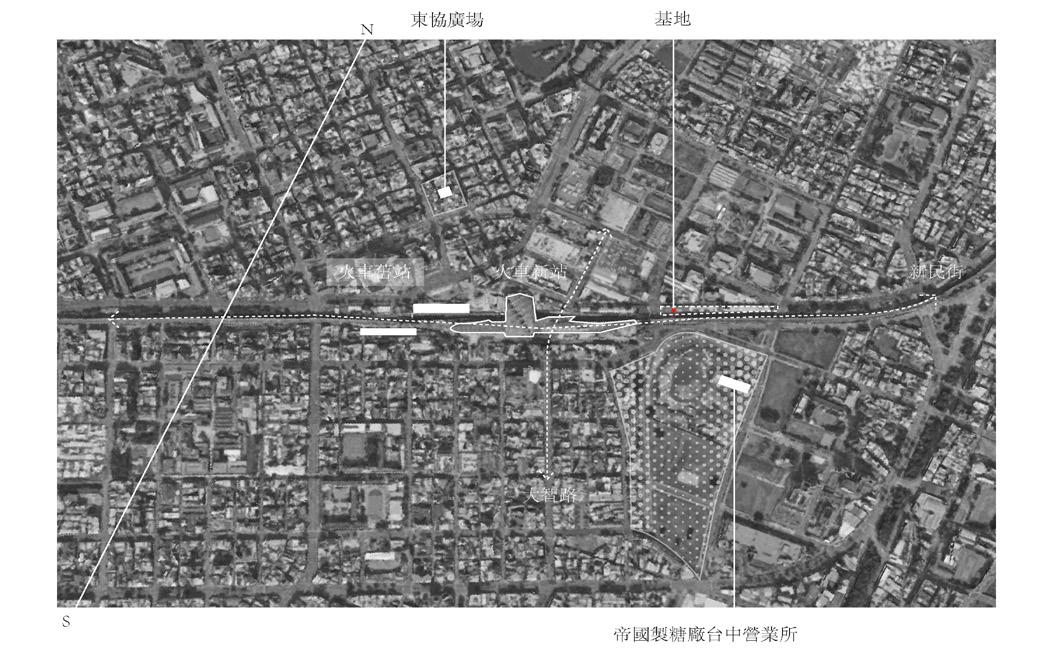
台灣社會並未對為經濟發展與社會服務做出貢獻的外籍 移工太多關注其社會文化面向的需求。以印尼籍移工為 例,社會無法滿足二十萬穆斯林移工的清真飲食及宗教 信仰需求,一其社會位階居於最底層;二其所屬行業的 工作性質不允許抽空從事宗教禮拜活動。一般臺灣雇主 不太可能允許穆斯林移工或外傭在週五參加主麻禮拜, 這對離鄉背井的移工們,卻是非常重要的社會與心理需因此,近幾年在伊斯蘭教中最重要的開齋節,印尼籍穆 斯林找不到足夠大的場地從事慶祝活動,只好群聚臺北 車站大廳席地禮拜與慶祝,卻無法取得來往旅客諒解, 引發占用公共場所的負面觀感。如何開創流動的公共空 間,創造外籍移工與本地台灣人良性互動與交流場所, 為當前的重要社會課題。
Taiwanese society has not paid much attention to the social and cultural needs of foreign migrant workers who contribute to economic development and social services. Taking Indonesian migrant workers as an example, society fails to meet the dietary and religious needs of two hundred thousand Muslim migrant workers, who occupy the lowest rungs of society.
Creating mobile public spaces to facilitate positive interactions and exchanges between foreign migrant workers and local Taiwanese people is an urgent social issue that needs to be addressed.

未竟之路



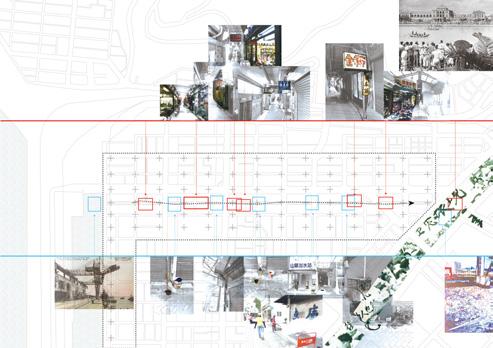

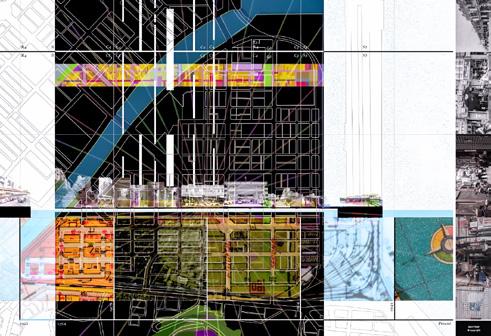
海岸是人文、都市、生活與水之間的連結拼貼。
高雄港,出現了兩個斷層的海岸,第一層已退縮風化至 鹽埕區的老城區裡,第二層仍不斷的在水岸邊隨著時間 與人潮呼吸。 高雄港在日治時期為陸海空軍皆有駐紮的區域,因運送 台灣的物資而建立了高雄港,也因此有許多進口舶來品 的走私,到了戰後初期更為興盛。高雄的鹽埕區也因此 成為最早被開發且繁榮的區域。然而在戰後嬰兒潮的時 間推演下,鹽埕區也成為了現在高雄市區高齡人口比例最高的區域。這是歷史推移後的必然結果。然而,在海港都市的休憩水岸更新之下,形成了生活紋 理上的裂縫。這個設計以對高雄港的這個觀察為出發, 進行一系列對高齡社區、活躍老化與水岸新灣區之間的 對話進行探索與思考。 戰後嬰兒潮與新興水岸生活休憩區的都 市裂縫,鹽埕區怎麼面對高齡與休憩?
In Kaohsiung Harbor, two distinct layers of the coastline have emerged. The first layer has receded and weathered into the old city area of Yancheng District, while the second layer continues to breathe with the passage of time and the ebb and flow of people along the waterfront.
Underneath the rejuvenation of the waterfront in the harbor city, a rift in the fabric of life and culture has emerged. This design want to explore and contemplate a series of dialogues between the aging community, active aging, and the newly developed waterfront district. It seeks to bridge the gap and foster a dialogue between these elements in the context of the rejuvenated waterfront area.
風化港都





在長途旅行中,人們需要休息、伸展、進食和補充能量, 能源站點能夠產生新節點嘗試擾動旅程、脫離絕對路線,顛覆以往人們對加油站的印象
視加油站為快速通過的 鄰避設施,僅是短暫補充能源或是清洗汽車的場所。電動車的充電時間和地點一直是個問題,電池受溫度和 速度影響,能耗不均,加上充電站網絡不足,造成里程 焦慮。 如果在南橫公路上根據地理形勢和狀況設置風力、水力 和太陽能發電的綠能設施,形成三個能源節點,或許能產生新的旅遊方式並解決能源問題。
山路並非連綿不斷,而是非均值、非各向同性的。旅程中, 我們經常困在座標軸的矛盾中,失去環境方向,無法探 索周遭環境。因此,我決定尋找旅途中的節點,探索新 的旅行方式。
短暫擺脫都市束縛
Initially, my focus was on exploring deep mountain travel, contemplating the journey of the soul.
In today's fast-paced society, people constantly navigate through the hustle and bustle under the influence of rapidly flowing information and pressure, leading to anxiety and depression.
I believe everyone needs moments to break free from urban constraints, alleviate stress, and, for me, deep mountain travel serves as a means to soothe emotions, cope with information overload, and rediscover the self.
Natural Navigation

最早新石器時代人類在此居住生活,依山傍水、靠採集 而生。隨著時間推進,因冬山河易氾濫,人們將祖先安 葬於此,而亡靈出現。因為過去開墾生活艱困、加上對 山區原住民的畏懼,人們將自然賦靈成為神靈依附於山
年代則因肺結核流行,天主教會在此設立療養院, 引入了西方的神靈。
冬山河旁的丸山小丘歷經時間承載著相異的「靈」,分 別為生靈、亡靈、神靈。
如今,亡靈與神靈已不復存在,應將這座山還給生靈, 透過去符號化的身體感知,棲居於天地之間、再現丸山 的靈。 對家鄉地景的當代凝視
The Wanshan Hill beside the Dongshan River carries different "spirits" through time, namely the living, the deceased, and the divine.
During the Neolithic era, humans inhabited this area. As time progressed, due to the frequent flooding of the Dongshan River, ancestors were buried here, giving rise to the spirits of the deceased. Because of the hardships of past colonization and the fear of the indigenous people, people endowed nature with spirits, attaching them to the hill.
Nowadays, the spirits of the deceased and the divine no longer exist. This mountain should be returned to the living. Through body perception, dwelling between heaven and earth, the spirits of the hill are once again manifested.
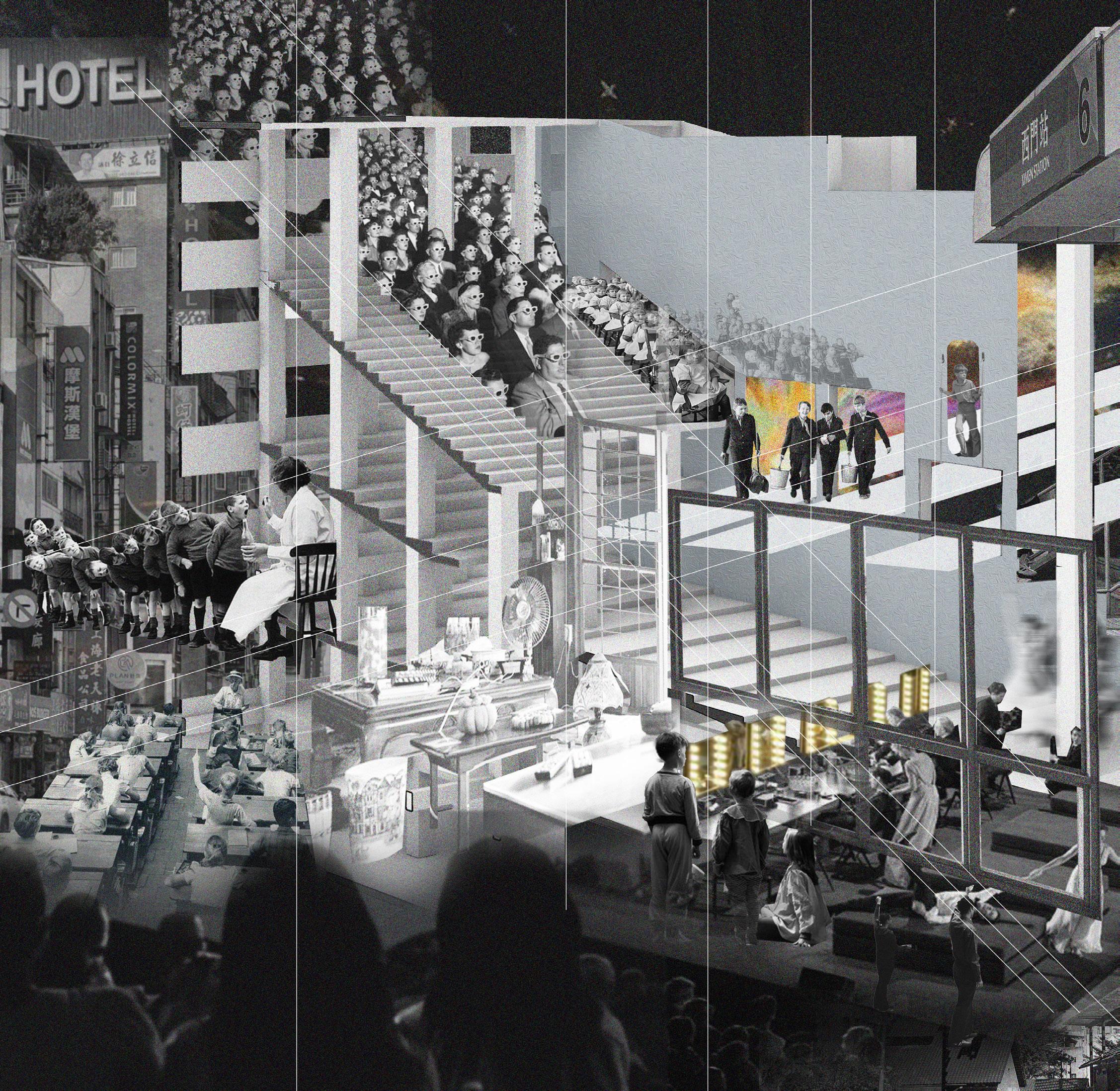
流動,我們不再只錨定於一個社群,住所開始在談論共享、而隨著時代的發展,家也從傳統的居住方式開始產生了 變動跟成長,我們開始同時從棲居中感知到自己和他人, 入在不同的群集中,他們的共享不只是和其他相同孤兒在這個家當中,孩童感知了自己與群集,以及不斷的投群體的空間被強調、而睡眠的地方足夠讓人冥想就好。我選擇以戲院(戲院)來與育幼院產生共融。
共享房間、而是和影院觀眾共享視野,他們的流動不只 是被動的遷移與拋棄、而是在不同群體間的變動,最後 「家」所強調的是自主性的建立生活方式、或他人、最 後是自己。
Most of us have a "home," a place where we stay and grow. Home is a "residence," unlike places such as schools, stations, hospitals, and libraries, where we don't calculate the time spent at home.
I chose to juxtapose a theater with a childcare facility.
In this home, children perceive themselves as part of a collective, engaging continuously with different groups. Ultimately, what the "home" emphasizes is the autonomy to establish a lifestyle, whether with others or oneself.
我們大多數人都有一個
家是一個「住所」,對於我們來說家是不具有時效性的, 跟學校、車站、醫院、圖書館不同,我們不會去計算在 家的時間。
“ 家 ” ,讓我們過夜和生長的地方,
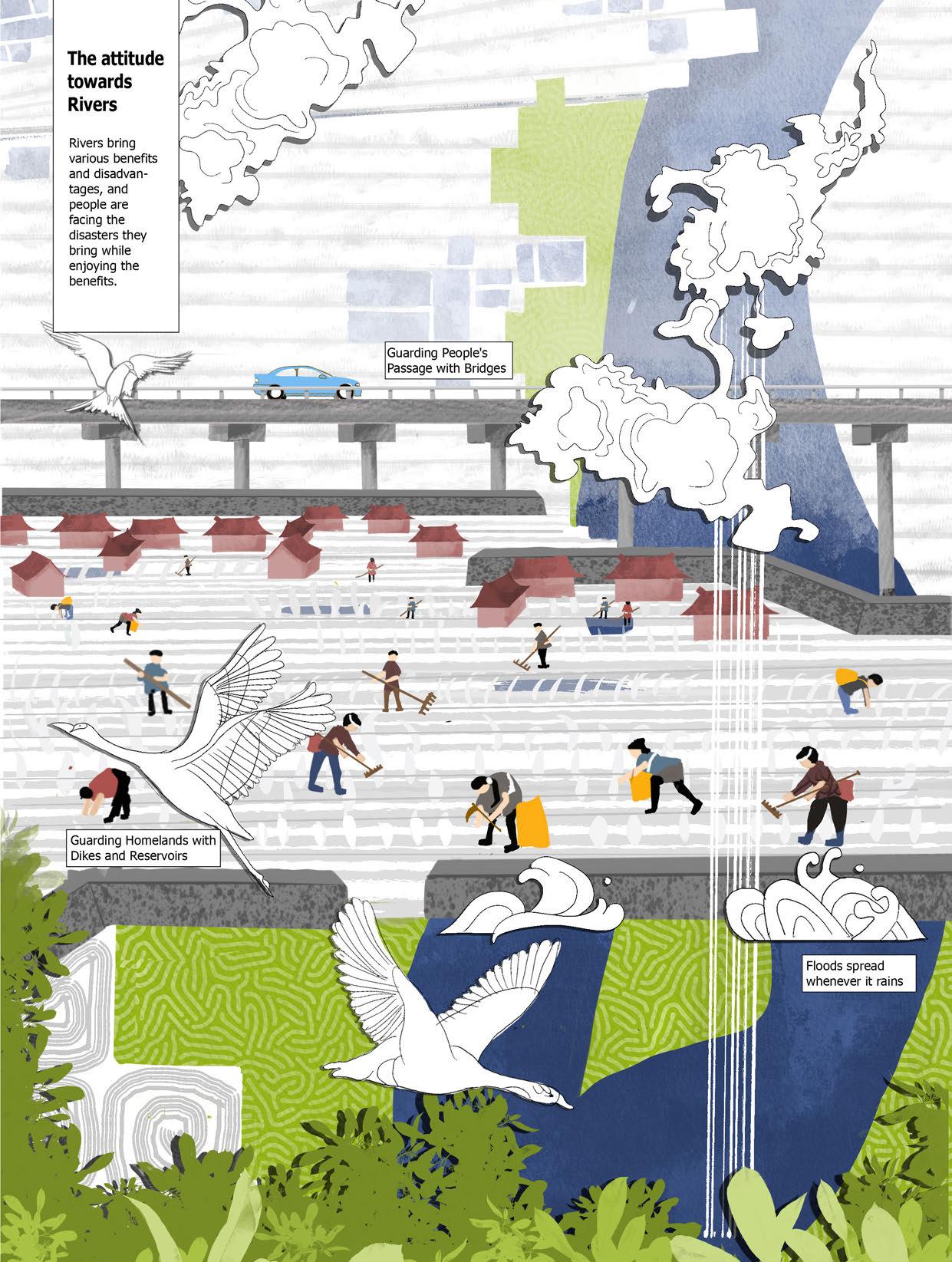
近曾文溪又稱青瞑蛇,在歷史記載中即是一條不穩定的 河川多次因山洪爆發改道,造成洪水氾濫,大量泥沙刷 入台江內海,使其淤積情況嚴重,台灣府城海岸線漸向 西擴展,衝擊內海地理環境,郊商航路於人民的生活形式。 河流與人帶來這些好處的同時,也帶來了一些挑戰。
人以堤防、水庫來保護家園,以橋樑來確保人們的通行。 儘管這條河流現在變得穩定且安全,但人們再悶無法輕 易靠近,河流周圍的區域不再適合其他物種生存。
Tseng Rivers have had an extremely important impact on ancient civilizations and human society, its has been diverted several times due to flash floods, causing flooding and sediment washes into the inland sea of the Taijiang, causing Taiwan's urban coastline to gradually expand westward, affecting the geographical environment of the inland sea and people's lifestyle.
While rivers bring these benefits, they also come with some challenges. Our ancestors used embankments and reservoirs to protect their homes, and bridges to ensure people's passage. Although the river is now stable and safe, it is inaccessible to people and the area around the river is no longer suitable for other species.
天,地,人,神的關係
陸,溪,橋,堤防的狀態
敬畏與否
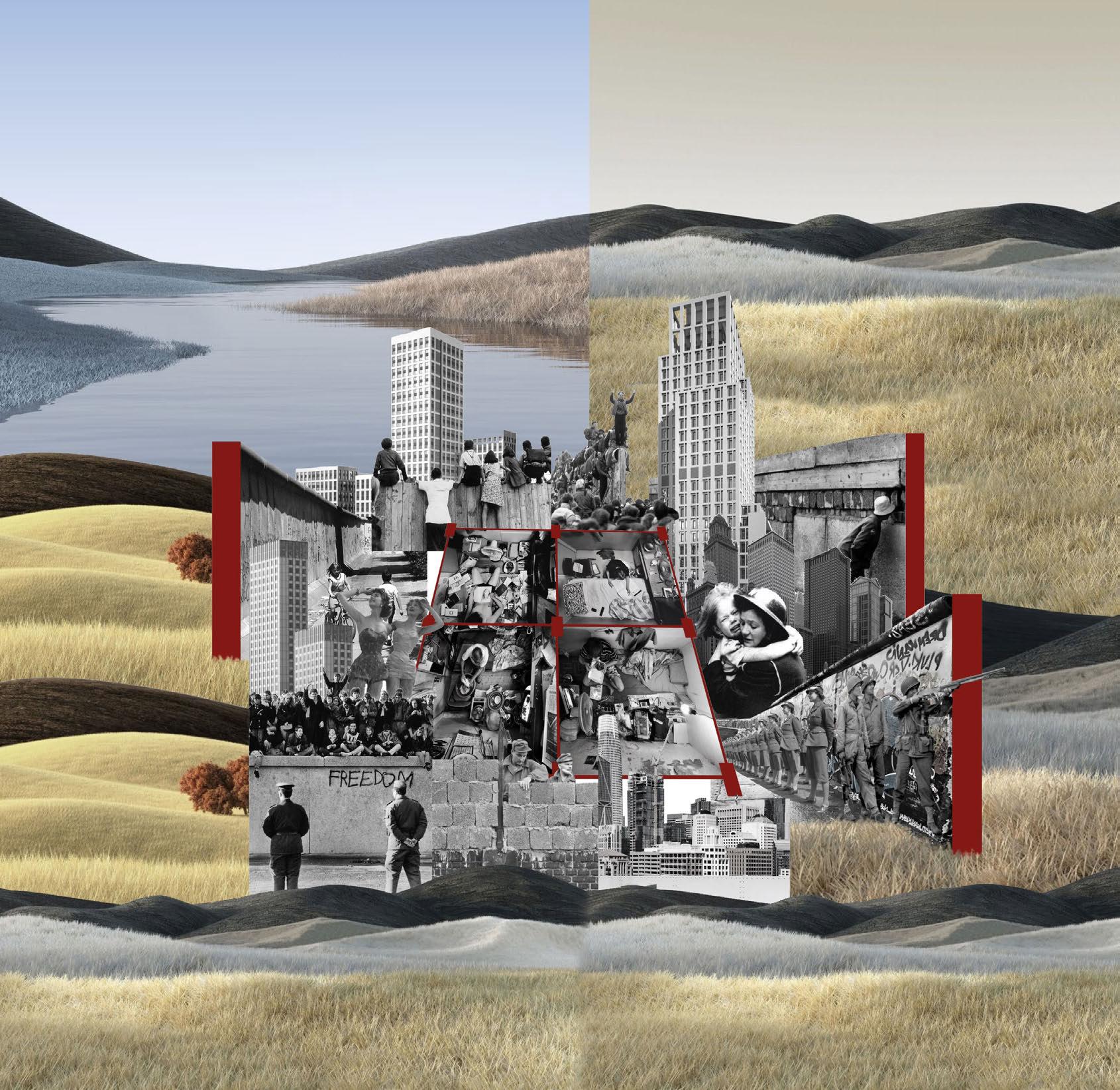
Taipei is a bustling hometown.I join countless unfamiliar Taipei residents in chasing time, playing the role of a robot that emerges precisely with the passage of time.
Taipei is filled with meticulou s co nvenien ce everyw h ere , and it s e ff ic ient pub li c tr a ns po rt a ti on and fac ilities ha ve m ad e it even ea sie r fo r me to cha se time I've grown acc usto med to b eing surro unded by the city's rhythm, where every device and co nvenient fea ture in the ur ba n settin g seems unrel a te d to me . The cha ng in g se aso ns and the w ax in g and waning moon have becom e disconnected from my life, relegated to the discarded background.
。 書 念 南 台 到 來 , 者 北 脫 為 成 我 前 年 五 , 北 台 在 長 生 小 從 我 小 從 。 異 差 的 大 最 受 感 北 脫 年 五 這 我 是 , 調 步 快 、 忙 繁 北 台 的 生 平 昧 素 數 無 旁 身 與 即 我 , 刻 那 門 家 了 出 從 打 。 人 器 機 的 現 湧 準 精 間 時 隨 演 扮 , 間 時 逐 追 同 人
、 能 機 與 輸 運 眾 大 的 利 便 , 利 便 的 至 不 微 無 是 處 處 北 台 , 圍 包 奏 節 的 市 城 被 慣 習 我 。 間 時 逐 追 利 順 更 我 讓 巧 恰 四 。 關 無 我 與 似 恰 然 自 讓 能 機 利 便 與 備 設 切 有 裡 市 都 被 是 , 節 脫 活 生 我 與 經 已 動 變 然 自 , 虧 盈 亮 月 、 迭 更 季 。 面 背 的 棄 摒 進 明 文 著 打 當 , 今 如 。 誕 荒 的 日 逐 父 夸 笑 嘲 們 我 , 經 曾 。 亡 死 到 直 間 時 逐 追 頭 裡 在 , 牆 起 築 願 甘 卻 們 我 , 旗 大 的 步 ﹁ 滿 裝 個 是 它 , 時 小 是 只 不 時 小 ﹂ 器 容 的 緒 情 和 頭 念 音 聲 、 味 香
嶼 花 現 花



Urban life undergoes changes with evolving cities, distancing people from urban spaces. Cities focus on selfimprovement, leaving many aspects unnoticed. Taipei's urban landscape symbolizes societal expectations, yet actual urban life differs. I aim to showcase authentic urban experiences in daily life. Choosing Dunhua NorthSouth Road and Ren'ai Road as a base, I seek to revitalize outdated urban planning spaces, aligning them with contemporary needs. This effort aims to bring hidden aspects of daily life in streets and alleys into the spotlight, creating a more nuanced understanding of urban existence.
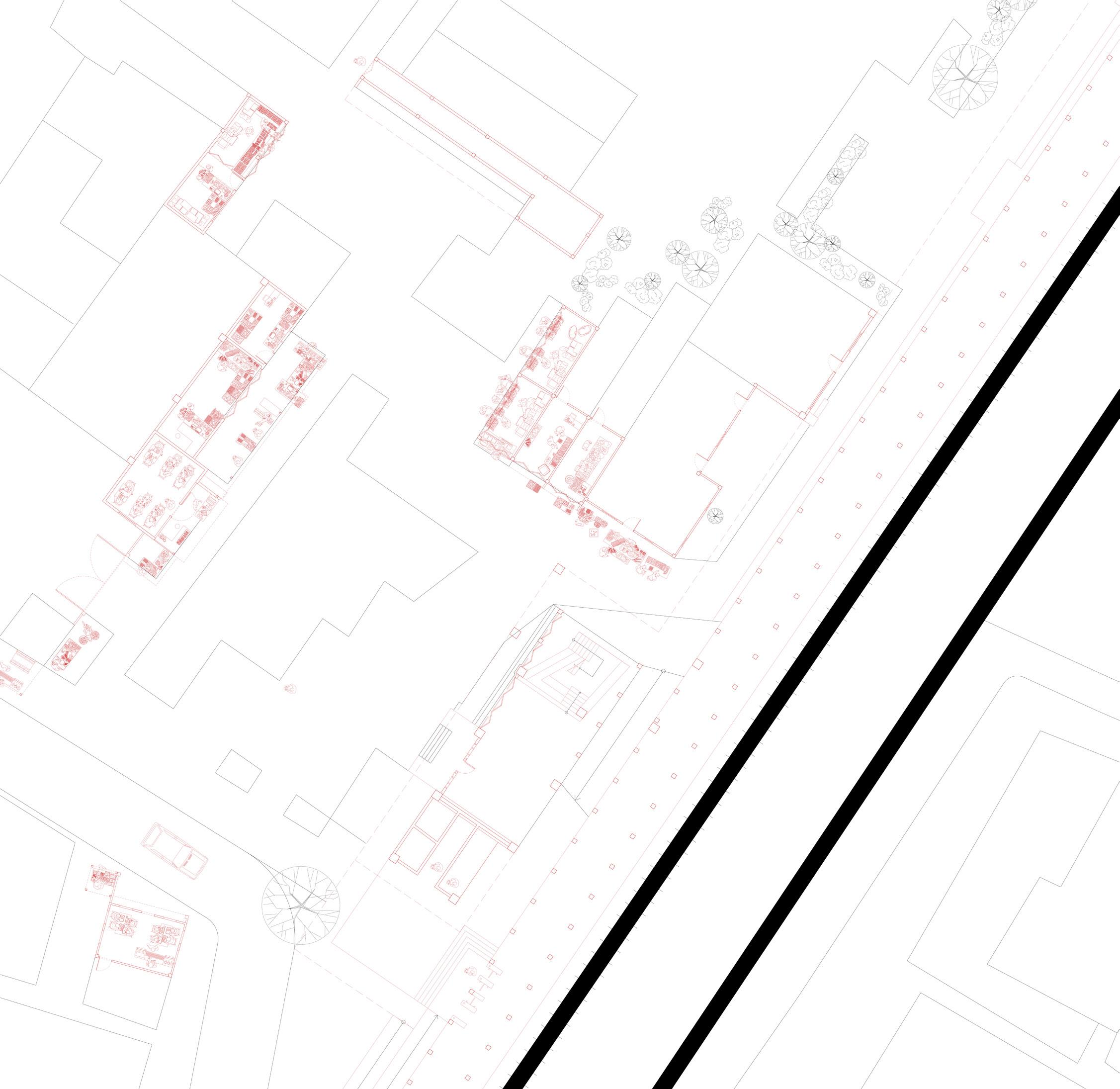
Reviving the Titipapan train station is vital for connecting local markets, schools, and the village office. Once dormant since the Dutch colonial era, the station now hosts illegal stalls and serves as a playground for children. Transforming it into a vibrant public space fosters community interaction and economic exchange.
The revamped station will be more than a transportation hub - it'll be a cultural center where residents gather, vendors sell goods, and events unfold. This initiative preserves heritage while creating opportunities for future generations.
Renovations, sustainable practices, and engaging activities will make it a symbol of vitality in the community.

虎尾美術 館
The project is located in the corner of the commercial belt in the center of the town, and the art museum is placed within it to become a place that is actively open to the public. Due to the demand for internal space, art galleries are often very large in size. Art galleries in small towns hope to maintain their splendor while showing their intimacy.
An immersive art museum, where people are surrounded by artworks. In the broad field of vision, thin boards suspended above support various types of activities. People engage in various activities throughout the art museum. But I was still surrounded by the main hall, and I kept seeing various types of exhibits surrounding it.
Huwei Art Museum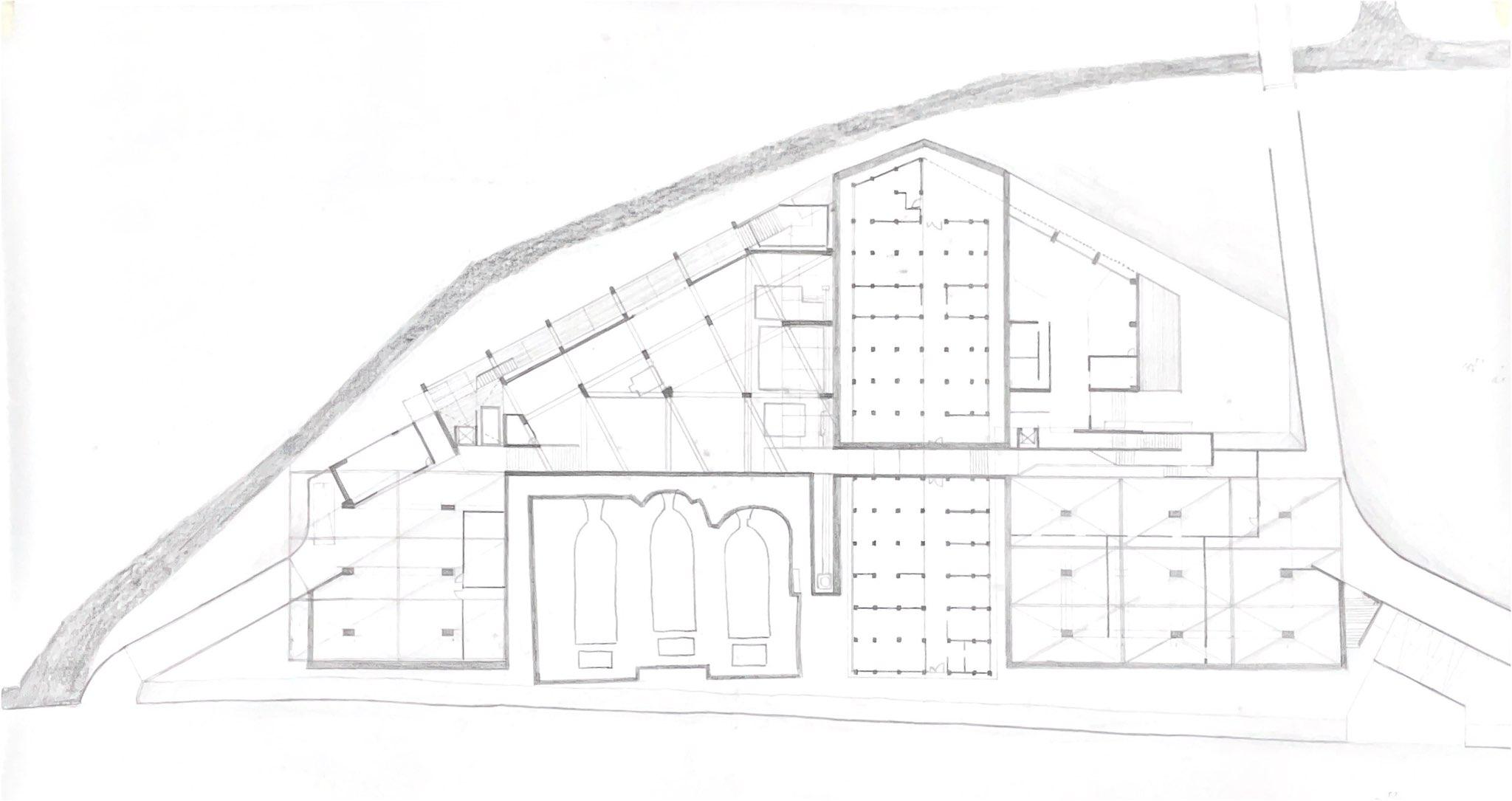

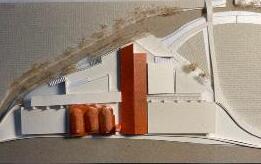
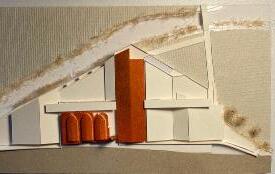
I chose a tile-making factory that was also about to be eliminated by the time as the design base. I gave the tilemaking project cultural legitimacy with a traditional craftsmanship attitude, integrated the architectural context system of the historical ancient kilns and tile houses, and integrated the new factory into it to make tiles.
The waiting cycle interprets the spirit of the place.
The white smoke slowly discharged from the chimney and the train that wakes up the old iron bridge every 5 minutes will give the base a inherited modern memory.

This place, once a vital entrance to Taipei City, is now the gateway to the western district. Whether arriving by the Airport MRT, exploring by subway, or strolling between Dihua Street and Wanhua with a suitcase, encounters are bound to happen here. It's a junction in life, where destinies converge. Whether coming or going, for a brief stop or an extended stay, this place is destined for meaningful encounters.
It's an interesting space with ongoing events. Whether for work, business trips, tourism, or passing through, this is a space for transitions, pauses, or longer stays. Here, meetings may be just a smile or a profound exchange, bridging distances.
Not only space but also time
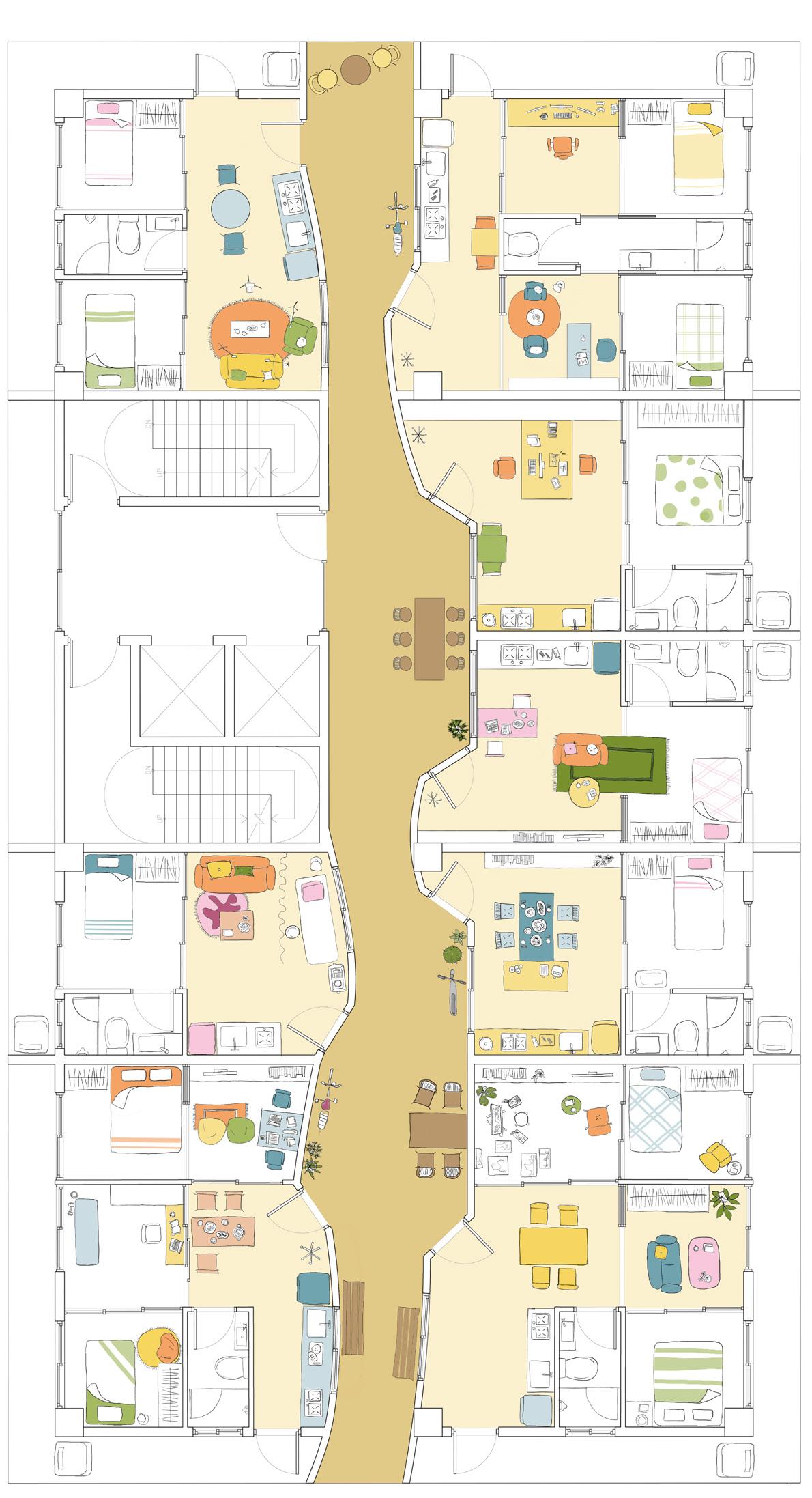
曾經的「臥室」早已不是「臥」室,人們在這個屬於自 己的小天地之中工作、學習、娛樂、甚至社交。居所當 然也不能再以客、餐、廚、臥幾個基本的生活機能去劃 分所有的空間。居室該當如何,才能囊括千百種人多樣 的生活型態? 我從隱私程度的角度切入,將居住空間切成三個層級「私密」、「私人但允許開放的可能」、「開放」。空 間的功能及用途未定,居住者可以依據個人的喜好及需 求填入相對應的機能。舉例來說,「私密」可以是睡眠、 盥洗、更衣;「私人但允許開放的可能」可以被一個居 家工作者作為工作室、美容業者作為服務客人的營業場 所、或是一個熱愛烹飪的人設備齊全的廚房;「開放」 可以是門前的小花園、停放腳踏車滑板的地方、甚至是和鄰居可以坐下來聊兩句的簡單桌椅。由「開放」空間所串起的公共空間恍若一條巷子,每家 每戶用自己的生活共同形成街道的樣貌,讓集合住宅裡 的走廊不再只是一條過道,而是與城市相連的街。
"Bedroom" is no longer "bed" room. In this little private space, people work, study, chill, and even social. Residence couldn’t be divided by basic functions like living, dinning, kitchen and sleeping any more. How to the design the living spaces to allow all the possibilities of lifestyle is the topic I want to work on. Approaching it from the perspective of privacy, I divide living spaces into three levels: "intimate," "personal but potentially open," and "open." The functions and purposes of these spaces remain undefined, allowing residents to customize them based on their preferences and needs. The public space interwoven by the "open" areas resembles a narrow alley, where each family contributes to the overall appearance of the street. In collective residences, corridors transform from mere passageways into streets connecting with the city, creating a sense of community and shared living.

停放腳踏車。

午後鄰里閒話家常。
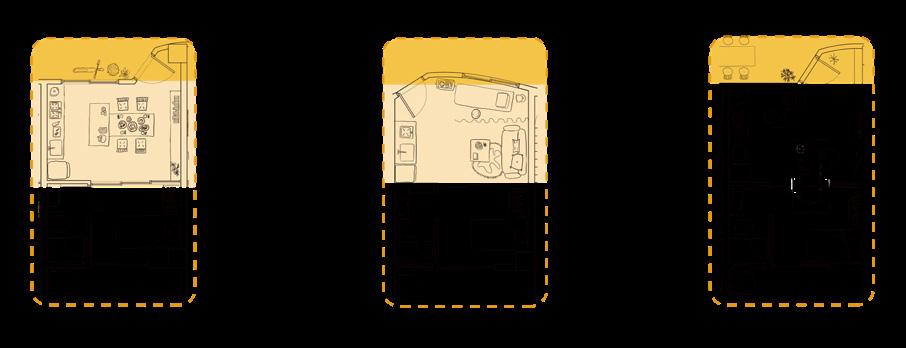
開放空間串起 住宅內的街道
指導老師/
熱愛烹飪的人 將空間打造成設 備齊全的廚房, 以私廚的形式招 待客人。
從事美容業,以 私人工作室的形 式營業
另有工作地點 者,將空間連通 使用,成為更寬 闊的起居空間。
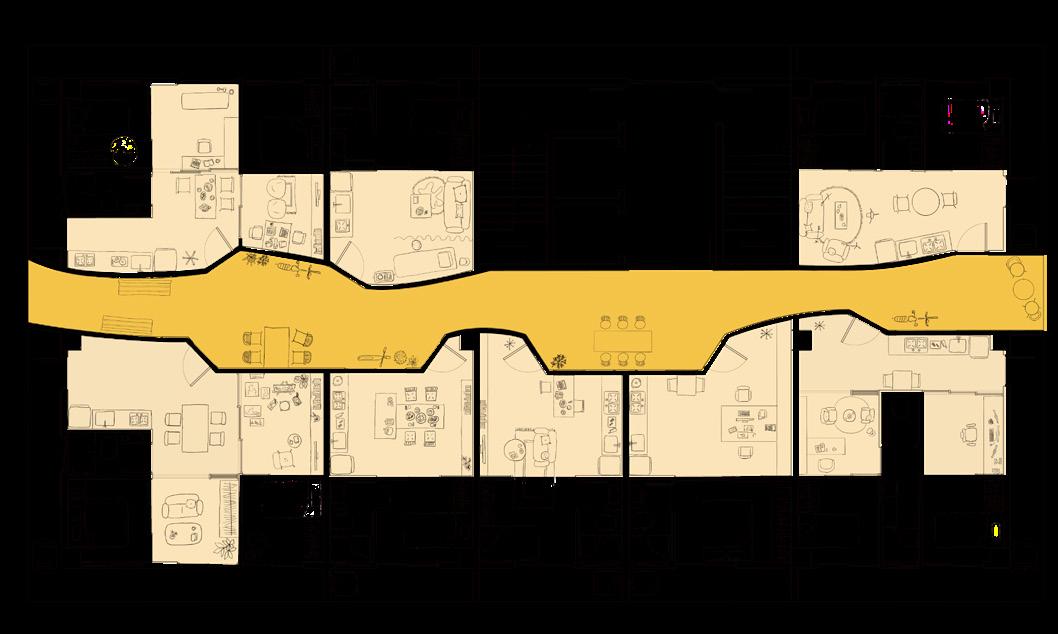
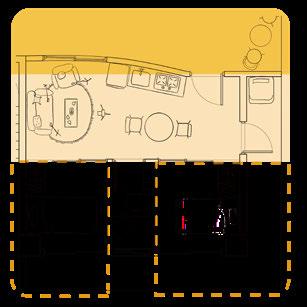


兩個網路工作者共同生活,將空間 作為拍片場地。 兩個朋友共同生活,各自擁有完整 的生活空間。一個有高度的電腦使 用需求,另一個提供諮商服務。 這個彈性的空間可以是個人的畫室,也可 以作為共同起居空間的延伸。

居室的演化
居之所向
新世代青年居室再定義
Where We Live
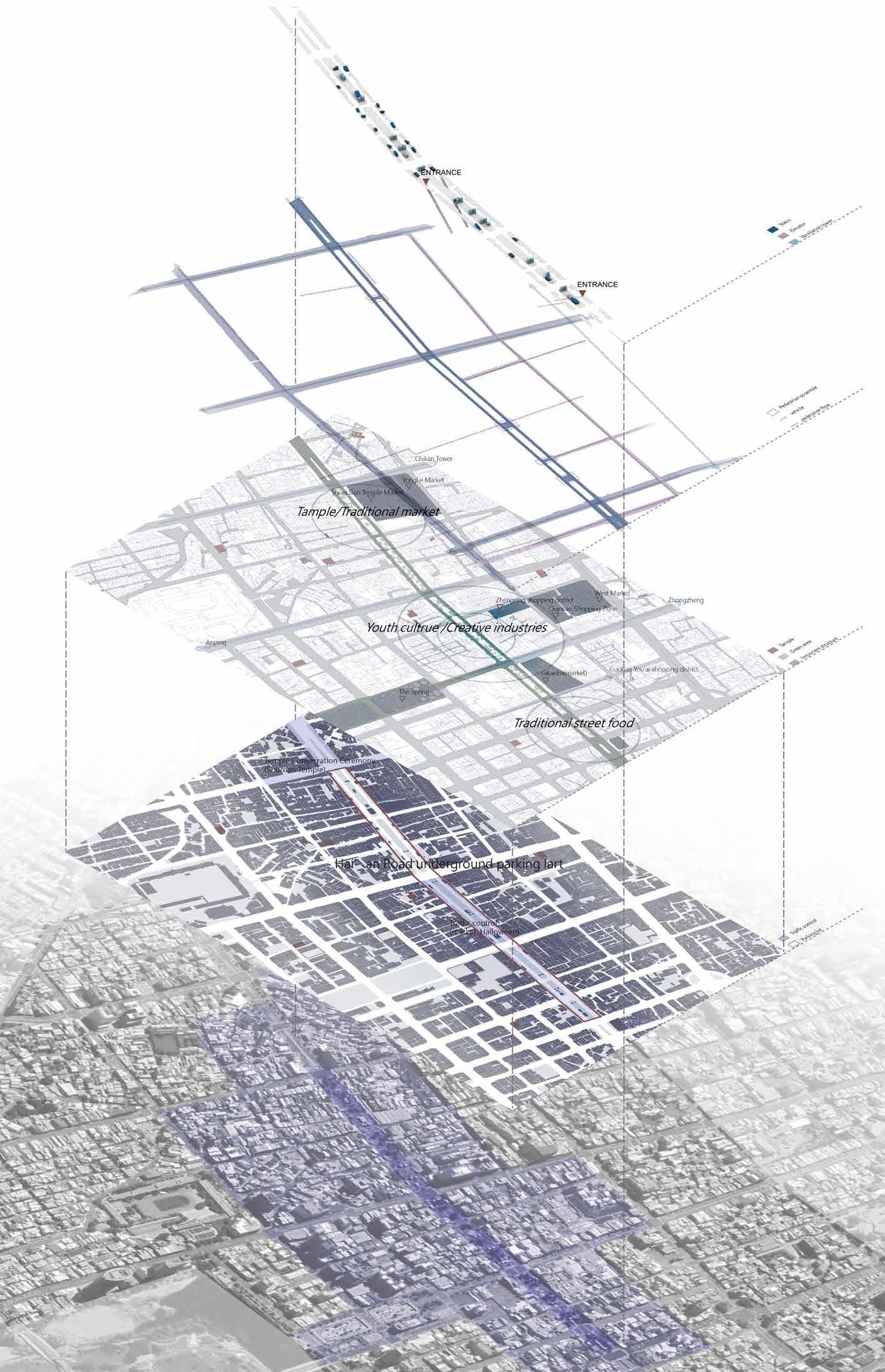



然而,在都市的緊湊步調下,對公共場所的爭奪經常限 制了舞者的表現空間。面對都市生活的壓力和商業化趨 勢,舞者們開始轉向傳統舞蹈教室進行活動。而街舞踏 入奧運舞台,雖然意味著逐漸融入主流文化,但也導致 舞蹈空間轉移至室內,逐漸與外界隔絕,並漸漸失去其 原始精神。 我思考是否可以通過重新創造場域來復興其最初的自由 精神?目的是為忙碌的都市生活提供一處喘息之地,一 個自由的城市舞台。
為了打破傳統、中心化的舞蹈環境,街舞逐漸演化為一 種無處不在的新型態舞種。在街頭隨意播放音樂,便能 吸引舞者和觀眾聚集。
都市街頭的場域重現







































































































































































